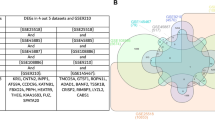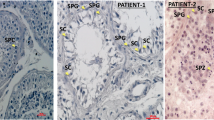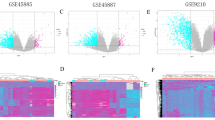Abstract
The Cancer/Testis Antigen (CTA) genes comprise a group of genes whose expression under physiological conditions is restricted to the testis but is activated in many human cancers. Depending on the particular expression pattern, the CTA genes are speculated to play a role in spermatogenesis, but evidence is limited thus far. Here, we reported patients with a hemizygous nonsense mutation in cancer-testis antigen 55 (CT55) suffering from male infertility with extreme disruption in sperm production, morphology, and locomotion. Specifically, the insufficiency of sperm individualization, excessive residue of unnecessary cytoplasm, and defects in acrosome development were evident in the spermatozoa of the patients. Furthermore, mouse models with depletion of Ct55 showed accelerated infertility with age, mimicking the defects in sperm individualization, unnecessary cytoplasm removal, and meanwhile exhibiting the disrupted cumulus-oocyte complex penetration. Mechanistically, our functional experiments uncovered CT55 as a new autophagic manipulator to regulate spermatogenesis via selectively interacting with LAMP2 and GABARAP (which are key regulators in the autophagy process) and further fine-tuning their expression. Therefore, our findings revealed CT55 as a novel CTA gene involved in spermatogenesis due to its unprecedented autophagy activity.
Similar content being viewed by others
Log in or create a free account to read this content
Gain free access to this article, as well as selected content from this journal and more on nature.com
or
Data availability
The data analysed during this study are included in this published article and the Supplementary data files. Additional supporting data are available from the corresponding authors upon reasonable request.
References
Hess RA, Renato de Franca L. Spermatogenesis and cycle of the seminiferous epithelium. Adv Exp Med Biol. 2008;636:1–15.
Cheng CY, Mruk DD. The biology of spermatogenesis: the past, present and future. Philos Trans R Soc Lond Ser B, Biol Sci. 2010;365:1459–63.
O’Donnell L, Nicholls PK, O’Bryan MK, McLachlan RI, Stanton PG. Spermiation: The process of sperm release. Spermatogenesis. 2011;1:14–35.
Boon T, Coulie PG, Van, den Eynde B. Tumor antigens recognized by T cells. Immunol today. 1997;18:267–8.
Chen YT, Old LJ. Cancer-testis antigens: targets for cancer immunotherapy. cancer J Sci Am. 1999;5:16–7.
Aurriere J, Goudenege D, Baris OR, Boguenet M, May-Panloup P, Lenaers G, et al. Cancer/Testis Antigens into mitochondria: a hub between spermatogenesis, tumorigenesis and mitochondrial physiology adaptation. Mitochondrion. 2021;56:73–81.
Lu C, Yang M, Rossi RM, Wang A, Feitosa WB, Diaz FJ, et al. Deletion of the mouse X-linked Prame gene causes germ cell reduction in spermatogenesis. Mol Reprod Dev. 2020;87:666–79.
Mi Y, Shi Z, Li J. Spata19 is critical for sperm mitochondrial function and male fertility. Mol Reprod Dev. 2015;82:907–13.
Donkor FF, Monnich M, Czirr E, Hollemann T, Hoyer-Fender S. Outer dense fibre protein 2 (ODF2) is a self-interacting centrosomal protein with affinity for microtubules. J Cell Sci. 2004;117:4643–51.
Fiedler SE, Dudiki T, Vijayaraghavan S, Carr DW. Loss of R2D2 proteins ROPN1 and ROPN1L causes defects in murine sperm motility, phosphorylation, and fibrous sheath integrity. Biol Reprod. 2013;88:41.
Young SA, Miyata H, Satouh Y, Aitken RJ, Baker MA, Ikawa M. CABYR is essential for fibrous sheath integrity and progressive motility in mouse spermatozoa. J cell Sci. 2016;129:4379–87.
Sinha D, Kalimutho M, Bowles J, Chan AL, Merriner DJ, Bain AL, et al. Cep55 overexpression causes male-specific sterility in mice by suppressing Foxo1 nuclear retention through sustained activation of PI3K/Akt signaling. FASEB J: Off Publ Federation Am Societies Exp Biol. 2018;32:4984–99.
Coutton C, Escoffier J, Martinez G, Arnoult C, Ray PF. Teratozoospermia: spotlight on the main genetic actors in the human. Hum Reprod update. 2015;21:455–85.
Gou LT, Kang JY, Dai P, Wang X, Li F, Zhao S, et al. Ubiquitination-Deficient Mutations in Human Piwi Cause Male Infertility by Impairing Histone-to-Protamine Exchange during Spermiogenesis. Cell. 2017;169:1090–104.e13.
Hansen JN, Rassmann S, Jikeli JF, Wachten D. SpermQ(-)A Simple Analysis Software to Comprehensively Study Flagellar Beating and Sperm Steering. Cells. 2018;8:10.
Alipour F, Jalali M, Nikravesh MR, Fazel A, Sankian M, Khordad E. Assessment of sperm morphology, chromatin integrity, and catSper genes expression in hypothyroid mice. Acta Biologica Hungarica. 2018;69:244–58.
Kawano N, Kang W, Yamashita M, Koga Y, Yamazaki T, Hata T, et al. Mice lacking two sperm serine proteases, ACR and PRSS21, are subfertile, but the mutant sperm are infertile in vitro. Biol Reprod. 2010;83:359–69.
Stolz A, Ernst A, Dikic I. Cargo recognition and trafficking in selective autophagy. Nat Cell Biol. 2014;16:495–501.
Ozturk N, Steger K, Schagdarsurengin U. The impact of autophagy in spermiogenesis. Asian J Androl. 2017;19:617–8.
Yin J, Ni B, Tian ZQ, Yang F, Liao WG, Gao YQ. Regulatory effects of autophagy on spermatogenesis. Biol Reprod. 2017;96:525–30.
Herpin A, Englberger E, Zehner M, Wacker R, Gessler M, Schartl M. Defective autophagy through epg5 mutation results in failure to reduce germ plasm and mitochondria. FASEB J: Off Publ Federation Am Societies Exp Biol. 2015;29:4145–61.
Shang Y, Wang H, Jia P, Zhao H, Liu C, Liu W, et al. Autophagy regulates spermatid differentiation via degradation of PDLIM1. Autophagy. 2016;12:1575–92.
Wang H, Wan H, Li X, Liu W, Chen Q, Wang Y, et al. Atg7 is required for acrosome biogenesis during spermatogenesis in mice. Cell Res. 2014;24:852–69.
Zhuo C, Ji Y, Chen Z, Kitazato K, Xiang Y, Zhong M, et al. Proteomics analysis of autophagy-deficient Atg7-/- MEFs reveals a close relationship between F-actin and autophagy. Biochem Biophys Res Commun. 2013;437:482–8.
Mizushima N, Levine B. Autophagy in mammalian development and differentiation. Nat Cell Biol. 2010;12:823–30.
Joachim J, Tooze SA. Control of GABARAP-mediated autophagy by the Golgi complex, centrosome and centriolar satellites. Biol Cell. 2018;110:1–5.
Nguyen TN, Padman BS, Usher J, Oorschot V, Ramm G, Lazarou M. Atg8 family LC3/GABARAP proteins are crucial for autophagosome-lysosome fusion but not autophagosome formation during PINK1/Parkin mitophagy and starvation. The. J Cell Biol. 2016;215:857–74.
Yamagata K, Murayama K, Okabe M, Toshimori K, Nakanishi T, Kashiwabara S, et al. Acrosin accelerates the dispersal of sperm acrosomal proteins during acrosome reaction. J Biol Chem. 1998;273:10470–4.
Park S, Kim YH, Jeong PS, Park C, Lee JW, Kim JS, et al. SPAM1/HYAL5 double deficiency in male mice leads to severe male subfertility caused by a cumulus-oocyte complex penetration defect. FASEB J: Off Publ Federation Am Societies Exp Biol. 2019;33:14440–9.
Dong XY, Li YY, Yang XA, Chen WF. BJ-HCC-20, a potential novel cancer-testis antigen. Biochem cell Biol = Biochim et biologie cellulaire. 2004;82:577–82.
Zhao H, Pan WM, Zhang HH, Song Y, Chen J, Xiang Y, et al. Cancer testis antigen 55 deficiency attenuates colitis-associated colorectal cancer by inhibiting NF-kappaB signaling. Cell Death Dis. 2019;10:304.
Liu G, Shi QW, Lu GX. A newly discovered mutation in PICK1 in a human with globozoospermia. Asian J Androl. 2010;12:556–60.
Dam AH, Koscinski I, Kremer JA, Moutou C, Jaeger AS, Oudakker AR, et al. Homozygous mutation in SPATA16 is associated with male infertility in human globozoospermia. Am J Hum Genet. 2007;81:813–20.
Mizushima N, Yoshimori T, Ohsumi Y. The role of Atg proteins in autophagosome formation. Annu Rev cell developmental Biol. 2011;27:107–32.
Feng Y, He D, Yao Z, Klionsky DJ. The machinery of macroautophagy. Cell Res. 2014;24:24–41.
Nakatogawa H, Suzuki K, Kamada Y, Ohsumi Y. Dynamics and diversity in autophagy mechanisms: lessons from yeast. Nat Rev Mol Cell Biol. 2009;10:458–67.
Huang Q, Liu Y, Zhang S, Yap YT, Li W, Zhang D, et al. Autophagy core protein ATG5 is required for elongating spermatid development, sperm individualization and normal fertility in male mice. Autophagy 2021;17:1753–67.
Rathje CC, Randle SJ, Al Rawi S, Skinner BM, Nelson DE, Majumdar A, et al. A Conserved Requirement for Fbxo7 During Male Germ Cell Cytoplasmic Remodeling. Front Physiol. 2019;10:1278.
Wilson GR, Wang HX, Egan GF, Robinson PJ, Delatycki MB, O’Bryan MK, et al. Deletion of the Parkin co-regulated gene causes defects in ependymal ciliary motility and hydrocephalus in the quakingviable mutant mouse. Hum Mol Genet. 2010;19:1593–602.
Leidal AM, Levine B, Debnath J. Autophagy and the cell biology of age-related disease. Nat Cell Biol. 2018;20:1338–48.
Huang G, Liu L, Wang H, Gou M, Gong P, Tian C, et al. Tet1 Deficiency Leads to Premature Reproductive Aging by Reducing Spermatogonia Stem Cells and Germ Cell Differentiation. iScience. 2020;23:100908.
Acknowledgements
We thank to the patients, their family members, and the normal controls for their support and contribution in this study. We thank to the Analytical and Testing Center of Sichuan University for the morphology characterization and the authors would be grateful to Guiping Yuan and Yi He for their help of TEM and SEM images.
Funding
This work was supported by The National Natural Science Foundation of China (82000514).
Author information
Authors and Affiliations
Contributions
YS designed and supervised the study experiments. Yihong Y, YW, QS and TZ collected the data and conducted the clinical evaluations of the participants. GZ and CJ performed most of the experiments and analyzed the data. Yanting Y, SD, Yushang Y, LY and ML participated in the experiments including immunofluorescence, western blotting and cell culture. HZ and XZ generated the CRISPR mice and conducted the fertility assessment. YS wrote the manuscript. All authors revised and approved the article.
Corresponding authors
Ethics declarations
Competing interests
The authors declare no competing interests.
Ethics approval
All the animal experiments were performed in accordance with the recommendation of the Guide for the Care and Use of Laboratory Animals of the National Institutes of Health and the animal experiments were approved by the Experimental Animal Management and Ethics Committee of West China Second University Hospital (IACUC no. 2021(070)). For human participants, the study was approved by the Ethical Review Board of West China Second University Hospital (IRB no. 2019(040)), Sichuan University.
Additional information
Publisher’s note Springer Nature remains neutral with regard to jurisdictional claims in published maps and institutional affiliations.
Edited by D. Aberdam
Supplementary information
Rights and permissions
Springer Nature or its licensor (e.g. a society or other partner) holds exclusive rights to this article under a publishing agreement with the author(s) or other rightsholder(s); author self-archiving of the accepted manuscript version of this article is solely governed by the terms of such publishing agreement and applicable law.
About this article
Cite this article
Zhang, G., Jiang, C., Yang, Y. et al. Deficiency of cancer/testis antigen gene CT55 causes male infertility in humans and mice. Cell Death Differ 30, 500–514 (2023). https://doi.org/10.1038/s41418-022-01098-6
Received:
Revised:
Accepted:
Published:
Issue date:
DOI: https://doi.org/10.1038/s41418-022-01098-6
This article is cited by
-
Autophagy accompanying the developmental process of male germline stem cells
Cell and Tissue Research (2024)
-
Selenium-Enriched Aspergillus oryzae A02 Enhances Testicular Antioxidant Capacity in Mice by Regulating Intestinal Microbiota and Serum Metabolite
Biological Trace Element Research (2024)
-
Spem2, a novel testis-enriched gene, is required for spermiogenesis and fertilization in mice
Cellular and Molecular Life Sciences (2024)



